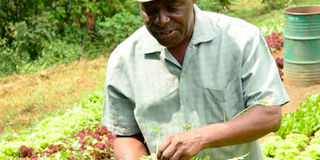Intercropping: a magic wand for farmers

John Musajjakawa intercrops various vegetables on his farm . File photo
What you need to know:
According to Catherine Atai, a seed multiplier at Kakusi-Igola in Serere District, intercropping method helps farmers get rid of the destructive weeds such as the deadly striga and stem borers, writes George Katongole.
The goal for any farmer, small or large, should be to get the most food out of their available space. One great practice is intercropping.
Catherine Atai, a seed multiplier at Kakusi-Igola in Serere District, started looking into alternative cropping systems in 2016.
Today, her two-acre land is intercropped with ground nuts, sorghum, chia seeds and simsim.
Positives
Intercropping has boosted Atai’s returns by increasing yield and lowering inputs for weed and disease control. Atai also sees less insect damage in her crops.
“I was advised at the National Semi Arid Resource Research Institute (NaSARRI) to try to beat some pests by inter-cropping and it is working wonders. If we can reduce use of insecticides, we would be happy as farmers. When inputs reduce, we increase our profit,” says Atai.
She likes the results, but admits it is no small challenge. The two or more crops planted together in the same field, benefit and support each other.
They take advantage of spatial variability and occupy different parts of the field profile. The diversity makes the mix more robust than a monoculture and therefore are less susceptible to diseases and pests.
When this is all added up the results are less inputs and a benefit known as ‘over yielding’.
Dr Paul Anguria, an agronomist who has worked on agronomy practices at NaSARRI in Serere, says intercropping, if done well gives the farmer the full benefits.
What to consider
The Consortium for Improving Agriculture-based Livelihoods in Central Africa (CIALCA) concluded that intercropping is an option to maintain soil fertility and maximise crop yields. It also mitigates crop failure risk, reduces pest and disease incidence, and controls weeds and soil erosion.
According to Dr Anguria, intercropping is ideal with right crop combinations.
“With the right crop combination, you would get over-yielding,” says Anguria, the head of programme, dry land legumes.
“Over-yielding occurs when the two crops yield more grain than a single crop would have yielded on the same piece of land.”
Mix and match
Dr Anguria, an agronomist specialising in dry land ecology, has researched intercropping and studied several crop combinations. He advises farmers to choose two crops that will mature at roughly the same time, or can wait while the other crop matures.
Maize and legumes, he says, are good choices for first time intercroppers.
“Both crops are very easy to harvest, so that’s a good one to start with,” he says.
Best crop combinations:
• Banana and coffee
• Legume and maize
• Legumes and vegetables
• Coffee and fruit trees
• Banana and vegetables
• Pumpkins and eggplants
• Maize and climbing beans
• Cassava and beans
• Potatoes and beans
Seeding
Farmers can seed each crop in its own row, known as strip intercropping, or mix the crops.
Anguria says strip intercropping often works better than mixed rows, but that’s not the case for every crop.
When sorghum is intercropped with ground nuts, one row of sorghum should be grown with three rows of sorghum. He advises farmers to plant seeds against the wind.
To get high yields, giving some crops a head start is important. He advises seeding peas deeper to reduce competition.
Fertilisation
When it comes to fertilising gardens, Anguria says that all fertilisers have similar traits of nitrogen, phosphorous and potassium.
Crops like alfalfa, beans, clover, cowpeas, lupines, peanut and soybean are used as nitrogen fixing plants.
On soil with low organic matter, the best results he has seen come from applying nitrogen. He advises farmers to apply less nitrogen to soil with high organic matter, as long as mineralisation is likely. For example, when legumes and cereals are seeded together, there is no need for fertilisers, Anguria says.
Rotation
Dr Anguria says, even with the several advantages of intercropping, farmers must consider crop rotation to cut the lifecycle of some diseases.
“Every farmer should consider intercropping but for it to be gainful, crop rotation should follow to replenish the soils with certain nutrients.




